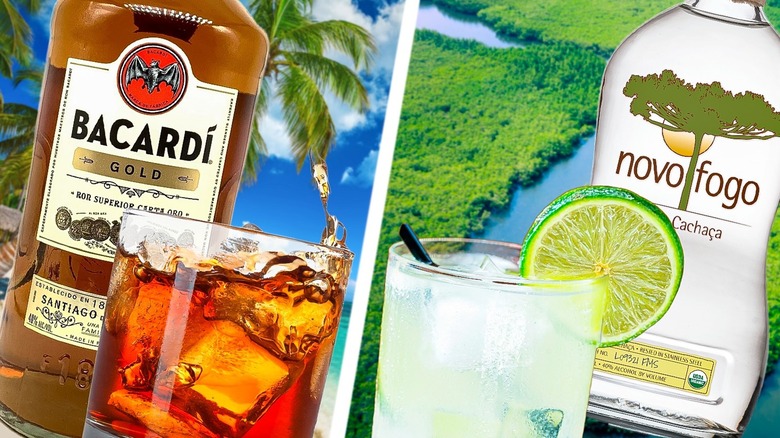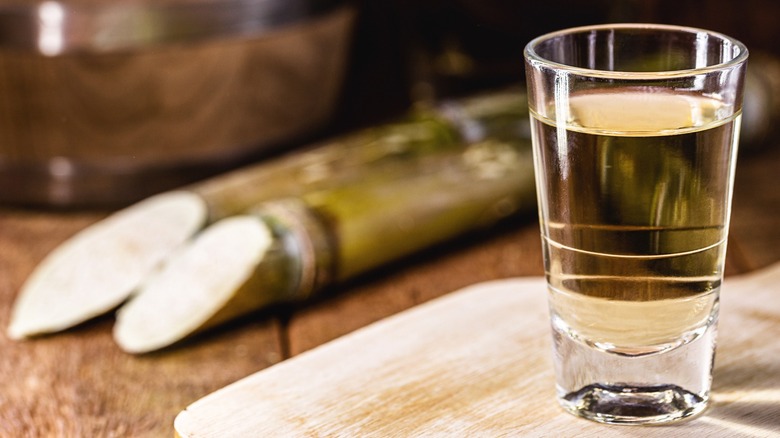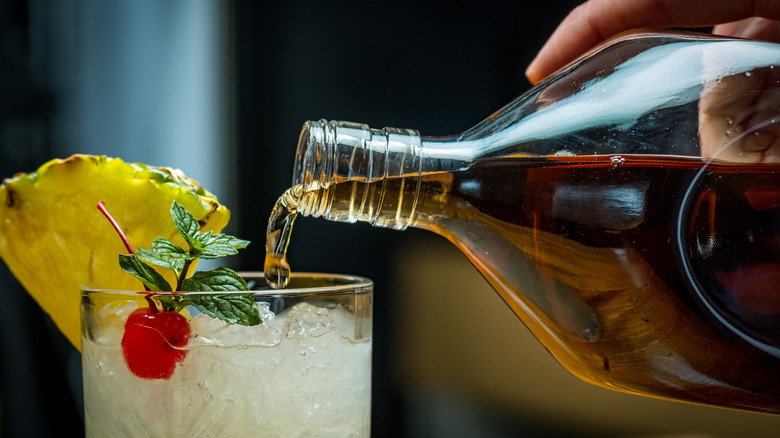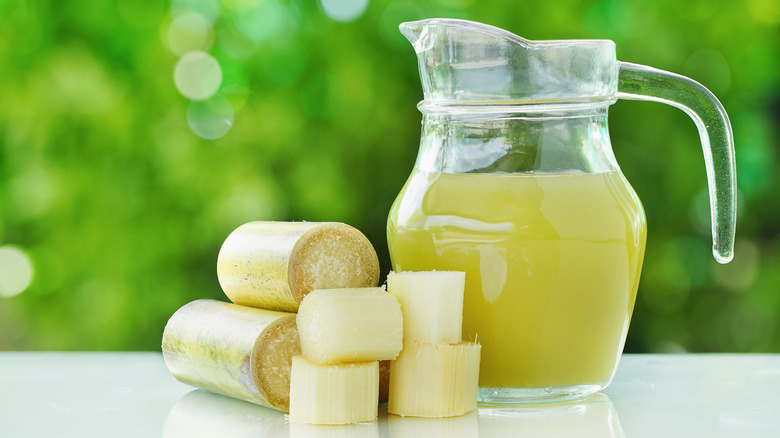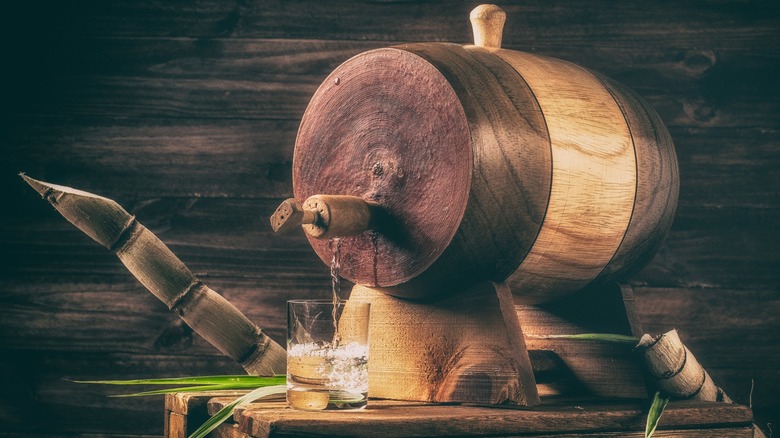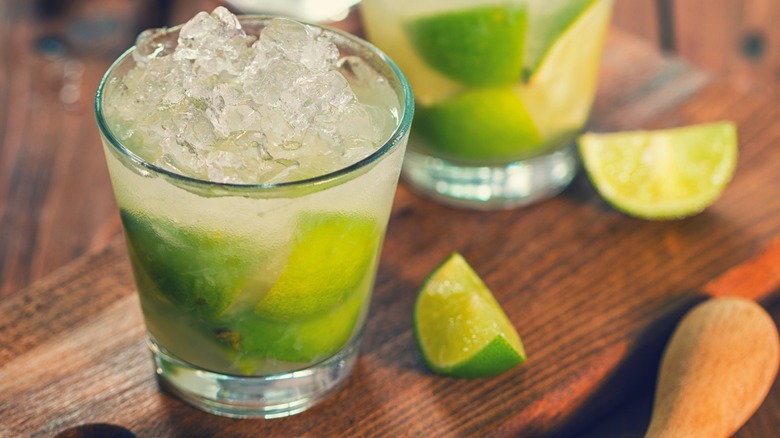Rum Vs Cachaça: The Real Difference Between The Two Spirits
All alcohol is made through the process of fermentation by feeding sugar to yeast. Wine uses the sugar in grapes, mead uses honey, and whiskey uses the sugar inside grains such as barley and corn. Both rum and cachaça go straight to the source by using sugar cane as their base. Depending on who you ask, rum and cachaça belong to the same category of spirits — but there are plenty of people who passionately claim the two are entirely unique.
The truth may be somewhere in between. It would probably be most accurate to depict rum and cachaça as variations on the same theme in the same way that bourbon and scotch are both whiskeys, though that's far from the official stance. There's also a third type of liquor made from sugar cane that would fit into this hypothetical rum family called rhum agricole, but that's a story for another time.
The histories of rum and cachaça intertwine at times before dispersing out and then back again. As the drink of choice for pirates and tourists alike – without a doubt, rum is the better-known of the two spirits. This is despite the fact that cachaça came first and is sometimes referred to as the Mother of Rum. In any case, cachaça has the honor of being the very first South American distilled spirit to ever exist.
What is cachaça?
Somewhat surprisingly, cachaça (pronounced kah-shah-sah) is the third-most consumed spirit in the entire world, though most of us aren't aware since 99% of that consumption happens in Brazil. Made from fermented fresh sugar cane juice, cachaça is a hidden gem that's quickly becoming Brazil's best worst-kept secret. If you've heard of cachaça already, you've probably heard of the cocktail it's most associated with – Brazil's national drink, the Caipirinha. A Caipirinha is made by muddling lime wedges and some sugar with cachaça and topping it off with ice. For being so simple, the drink has no business tasting so good.
The origin of cachaça is a little less laissez-faire, given that it's a direct outcome of the Portuguese sugar cane plantations that cropped up in the 1500s. There are a few variations on the origin story but it was either the slaves running the plantations who made the first cachaça from the excess foam that gathers when processing sugar cane into sugar or it was the Portuguese plantation owners who used their knowledge of Arabic distilling methods to make the spirit from their produce.
Either way, cachaça spent the first years of its life being a cheap alcohol favored by Brazilian slaves before becoming a popular drink enjoyed by all social classes by the 1700s. This dichotomy has continued to this day. In modern Brazil, there are plenty of cheap, mass-produced cachaças that counterbalance the expensive craft cachaças that only the wealthy can afford.
What is rum?
Similar to cachaça, rum was born out of colonial sugar plantations scattered throughout the Caribbean islands. The first written record of rum dates back to 1650, a full 100 years after cachaça had gotten its start further south. It would go on to play a pivotal role in American history, where it was enjoyed as a cheap alternative to more expensive luxuries like brandy and port. Whiskey overtook rum as the drink of choice only after Britain taxed molasses into obscurity in an effort to regain control over the American economy.
The plan backfired, obviously, though a rum-fueled America is an interesting alternate history that might have been. Today, you'll see rum classified into different categories. Dark rum is the original version, thick as molasses. Jamaica and Barbados specialize in this type of rum. It wasn't until the 19th century that you began to see light rums that were golden or clear. Cuban and Puerto Rican rums tend toward the lighter side.
You won't find many people outside of the Caribbean sipping rum on the rocks, though there are plenty of premium rums that deserve the honor. Most of the time, rum gets mixed in with something else as in a Rum & Coke or a Daiquiri. But rum reaches its apex in the world of tiki drinks. Arguably the greatest category of cocktails to ever exist, tiki drinks will often blend both dark and light rums together to create legendary concoctions like Donn Beach's Zombie.
Cachaça is made by fermenting fresh sugar cane juice
Even though both rum and cachaça use sugar cane as their primary ingredient, they don't use it in the same way. To understand what we mean, let's talk a little about how sugar is made. After sugar cane is harvested, the stalks are crushed, which releases fresh sugar cane juice. The juice is then boiled and centrifugally spun to separate the sugar crystals from the impurities. These impurities are what we call molasses. Sugar producers will boil and spin the mixture three times, producing darker and darker molasses each time until they end up with blackstrap molasses.
Cachaça is made from fermenting fresh sugar cane juice by adding yeast to it. After it's done fermenting, the liquid is distilled and you end up with cachaça. Pretty straightforward. Rum is a little bit more difficult to define because there are less hard-set rules surrounding its production. That said, rum is most commonly made by fermenting and distilling molasses. You can technically make rum from fresh sugar cane juice, but it's not typical.
Using fresh sugar cane juice is a major reason why cachaça has such a bright, vegetal flavor profile whereas rum will often have the familiar thick sweetness of rich molasses. Lighter rums use a variety of tactics to lighten the palate (including filtration), but as a general overview, it's useful to remember where these drinks come from.
Rum is often aged in old bourbon barrels
Another major factor in the flavor differences is how these drinks are aged. A good chunk of the cachaça produced is unaged, essentially going straight from the still to the bottle. Cheaper cachaças, in particular, will take advantage of this. Some cachaça will be left to rest in stainless steel vats for about a year before being bottled which is said to soften the harsher edges. But what's really unique about aged cachaça is that there are no restrictions on what kind of wood it can be aged in.
Most other spirits have specific types of wood they can use, such as new oak barrels for whiskey. Cachaça can be aged in oak, but many distilleries will use Brazil nut, araúva, amburana, jequitibá, balm, and many other locally sourced wood for barrels – each of which offers its own unique flavor profile to the mix. The choice of wood and how long the cachaça is aged will affect its color as well.
The vast majority of gold and dark rums are aged in used oak barrels, specifically old bourbon barrels. A requirement for making bourbon is that the barrels they age in must be new every time. Once the bourbon is finished, rum producers will buy the barrels and use them to age their products. It's a common practice shared by other aged spirits, as well. Light rums don't want the added color that used bourbon barrels impart so they'll often be aged in stainless steel vats before being filtered.
Cachaça is only produced in Brazil
Rum can be found all over the world, though its production naturally congregates around the tropical and subtropical regions where sugar cane grows. Caribbean islands like Jamaica, Haiti, and Cuba are some of the first to come to mind, but you can find excellent rums coming out of India, the Philippines, and Australia, as well. The global presence of rum helps explain why more people are familiar with it as a liquor category. Cachaça, on the other hand, is not a global phenomenon.
Much like other regionally-designated alcohols such as Champagne and Cognac, cachaça cannot be legally produced anywhere except Brazil. There are thousands of cachaça distilleries throughout the country, but only a handful are investing in the global distribution of their product, which explains why this spirit is not as well-known. Over the past few decades, this has begun to change. Cachaça distilleries with the means to tackle the problem are seeing a large, untapped market in the global economy and are beginning to turn their focus outside of Brazilian borders.
When cachaça first began selling in the United States, it was labeled as Brazilian rum – either out of convenience or through ignorance. It didn't take long for Brazil to correct the mistake, but it could help explain the confusion surrounding these two spirits. These days, you'll be hard-pressed to find a cocktail bar worth their salt that doesn't have some cachaça on the shelf and we are already seeing innovative new cocktails based around the recently added spirit.
